
There are several different methods for selecting a block of cells in Excel, or extending an existing selection with more cells. Let’s take a look at them.
有几种不同的方法可用于在Excel中选择单元格块,或使用更多单元格扩展现有选择。 让我们看看它们。
通过单击和拖动选择单元格范围 (Select a Range of Cells By Clicking and Dragging)
One of the easiest ways to select a range of cells is by clicking and dragging across the workbook.
选择一系列单元格的最简单方法之一是在工作簿上单击并拖动。
Click the first cell you want to select and continue holding down your mouse button.
单击要选择的第一个单元格,然后继续按住鼠标按钮。
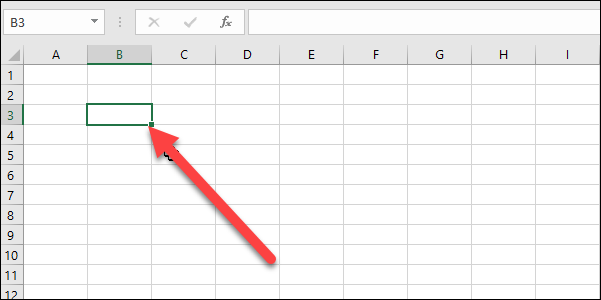
Drag your pointer over all the cells you want in the selection, and then release your mouse button.
将指针拖到选择中所需的所有单元格上,然后释放鼠标按钮。

You should now have a group of cells selected.
现在,您应该已经选择了一组单元格。
使用Shift键选择大范围的单元格 (Select a Large Range of Cells With the Shift Key)
Sometimes, clicking and dragging isn’t convenient because the range of cells you want to select extends off your screen. You can select a range of cells using your Shift key, much the same way you’d select a group of files in a file folder.
有时,单击和拖动并不方便,因为要选择的单元格范围超出了屏幕。 您可以使用Shift键选择一系列单元格,与在文件夹中选择一组文件的方式几乎相同。
Click the first cell in the range you want to select.
单击要选择的区域中的第一个单元格。
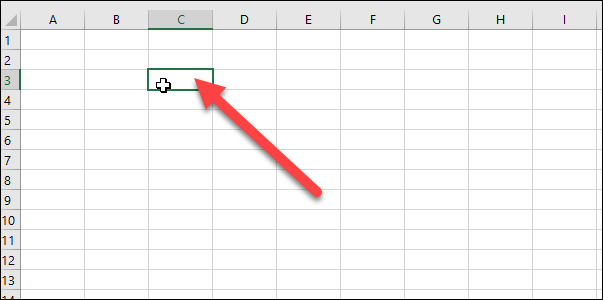
Scroll your sheet until you find the last cell in the range you want to select. Hold down your Shift key, and then click that cell.
滚动工作表,直到找到您要选择的范围中的最后一个单元格。 按住Shift键,然后单击该单元格。
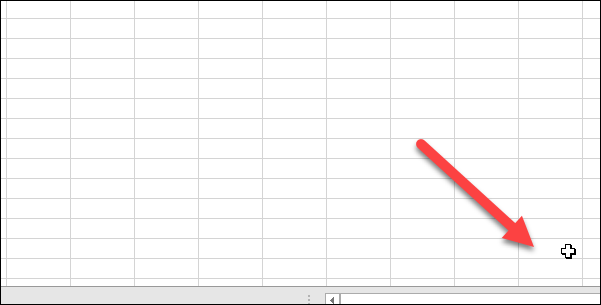
All the cells in the range are now selected.
现在选择了该范围内的所有单元格。
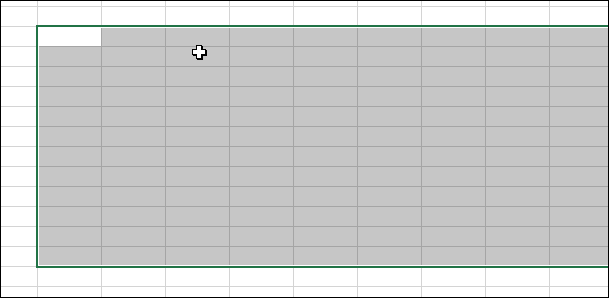
使用Ctrl键选择(或取消选择)范围外的独立单元格 (Select (or Deselect) Independent Cells Outside a Range With the Ctrl Key)
You can also select multiple cells that are not connected to one another by using your Ctrl key.
您也可以使用Ctrl键选择多个彼此不连接的单元格。
Click the first cell you want to select.
单击您要选择的第一个单元格。

Now, hold down the Ctrl key and click to select additional cells. In the image below, we’ve selected five different cells.
现在,按住Ctrl键并单击以选择其他单元格。 在下图中,我们选择了五个不同的单元格。

You can also use your Ctrl key to deselect an already selected cell—even from a selection range. In the image below, we deselected several cells from a range of cells we’d already selected just by holding down the Ctrl key while clicking the cells.
您还可以使用Ctrl键取消选择一个已经选择的单元格,甚至从选择范围内取消选择。 在下面的图片中,我们通过在单击单元格的同时按住Ctrl键,从已经选择的一系列单元格中取消选择了几个单元格。
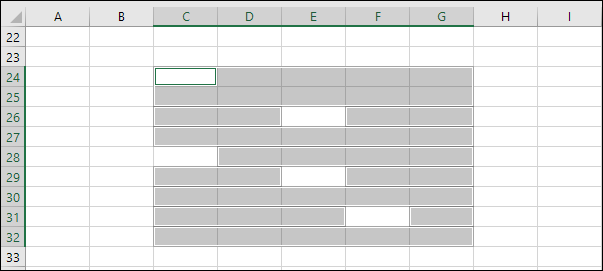
使用名称框选择单元格范围 (Select a Range of Cells Using the Name Box)
If you know the exact range of cells you want to select, using the name box is a useful way to make the selection without any clicking or dragging.
如果知道要选择的单元格的确切范围,则使用名称框是进行选择的有用方法,而无需任何单击或拖动。
Click the name box in the top left of the workbook.
单击工作簿左上方的名称框。

Type in the range of cells you want to select using the following format:
使用以下格式输入要选择的单元格范围:
First Cell:LastCell
Here, we’re selecting all the cells from cell B2 (our top left cell) to F50 (our bottom right cell).
在这里,我们选择从单元格B2(左上角的单元格)到F50(右下角的单元格)中的所有单元格。

Hit Enter (or Return on Mac), and the cells you input are selected.
按下Enter键(或在Mac上为Return键),然后选择您输入的单元格。
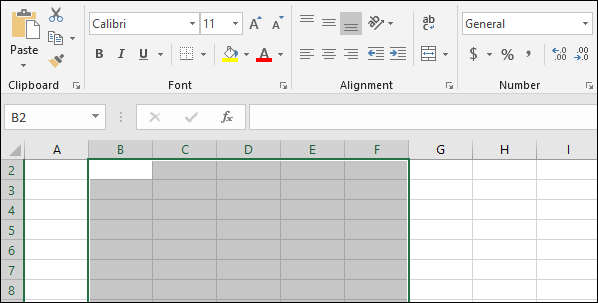
选择整个单元格行 (Select an Entire Row of Cells)
You may need to select an entire row of cells at one time—perhaps to apply formatting a header row. It’s easy to do this.
您可能需要一次选择一整行单元格,也许要应用格式化标题行。 这很容易做到。
Just click the row number at the left hand side of the row.
只需单击该行左侧的行号。
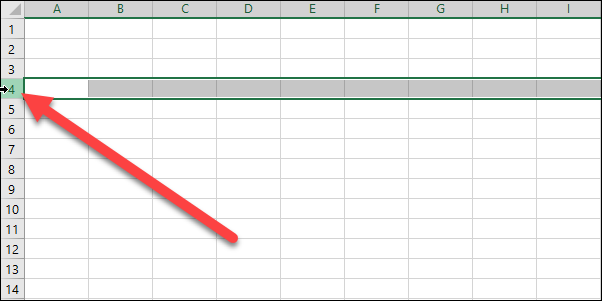
The entire row is now selected.
现在选择了整个行。
选择多个单元格的整个行。 (Select Multiple Entire Rows of Cells.)
Sometimes, you may want to select multiple entire rows cells. Much like with selecting individual cells, you’ll use the Shift key if the rows are contiguous (or you can click and drag) and the Ctrl key if the rows are noncontiguous.
有时,您可能希望选择多个整行单元格。 与选择单个单元格非常相似,如果行是连续的(或者可以单击并拖动),则可以使用Shift键;如果行是非连续的,则可以使用Ctrl键。
To select a contiguous set of rows, click the row number of the first row.
要选择一组连续的行,请单击第一行的行号。

Continuing to hold down your mouse button, drag your cursor across all the rows you want to select. Or, if you prefer, you can hold down your Shift key and click the bottom-most row you want to select. Either way, you’ll select a range of rows.
继续按住鼠标按钮,将光标拖到要选择的所有行上。 或者,如果您愿意,可以按住Shift键并单击要选择的最底行。 无论哪种方式,您都将选择行范围。

To select noncontiguous rows, click the row number of a row you want to select.
要选择不连续的行,请单击要选择的行的行号。

Then hold down your Ctrl key while clicking the row numbers of additional rows you want to add to the selection. In the image below, we’ve selected several rows that are noncontiguous.
然后,按住Ctrl键,同时单击要添加到选择中的其他行的行号。 在下图中,我们选择了几行不连续的行。
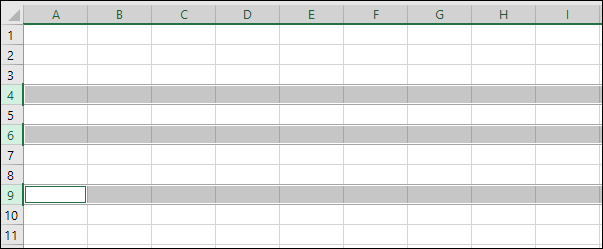
And, just like with individual cells, you can also use the Ctrl key to deselect rows from a selected range. In the image below, we’ve deselected two rows from a selected range by holding down the Ctrl key while clicking the row numbers of the rows we didn’t want in the selection.
而且,就像单个单元格一样,您也可以使用Ctrl键从选定范围内取消选择行。 在下图中,通过按住Ctrl键的同时单击选择中不需要的行的行号,我们已从选定范围中取消选择了两行。
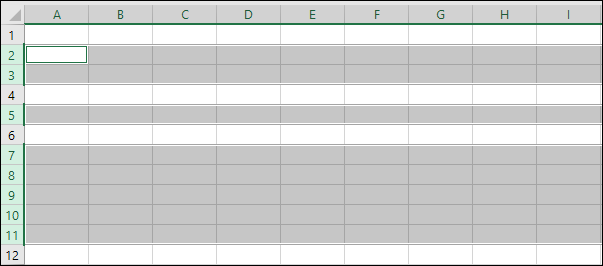
选择一个或多个整列单元格 (Select One or More Entire Columns of Cells)
Sometimes, you may want to select an entire column of cells. It’s easy to do this, too. In fact, it works exactly like selecting rows.
有时,您可能需要选择整个单元格列。 这也很容易。 实际上,它的工作原理与选择行完全相同。
Click a column letter to select the column.
单击列字母以选择列。

You can also select multiple columns by clicking and dragging or by using the Shift key, just like with rows. The Ctrl key also works for selecting noncontiguous columns or for deselecting columns from a selected range.
您也可以通过单击并拖动或使用Shift键来选择多列,就像处理行一样。 Ctrl键还可用于选择不连续的列或从选定范围内取消选择列。
本文链接:https://my.lmcjl.com/post/3302.html

4 评论